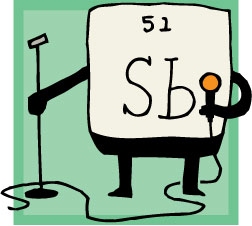Blogging the Periodic Table

Despite its obscurity, probably no element on the periodic table has as colorful a history as antimony. Money, madness, poison, linguistics, charlatanism, sex—pretty much every theme that runs through the periodic table can be found in Element 51.
Let's start with the charlatan. In the early 1600s, a merchant named Johann Thölde divided his time three ways: running a salt mine in rural Germany, studying alchemy, and serving as secretary of the Rosicrucian Brotherhood, a society, one historian says, "founded on literary fraud and saturated with it." Totally in character, then, Thölde claimed one day he'd been in a local monastery when a storm swept in and a "miraculous thunderbolt" split open a marble pillar. Out tumbled a load of books, including The Triumphal Chariot of Antimony, an alchemical text.
Thölde further claimed that a persecuted monk and secret alchemist named Basil Valentine had hidden the book in the pillar 150 years before. Amid its alchemical spells, the book explained how to prepare compounds of antimony, an element important to certain sects of alchemists—including, not coincidentally, Thölde's. The seeming ancientness and authority of the book probably boosted the prestige of the Rosicrucians in comparison with other groups of alchemists.
Even by 1710, Gottfried Leibniz, co-inventor of calculus, had declared the manuscripts obvious frauds, and most scholars today doubt that Thölde's Basil Valentine existed. Yet the doubts didn't stop Isaac Newton, a devoted alchemist and Leibniz's rival in inventing calculus, from becoming obsessed with antimony. Newton actually spent more time studying antimony than gravity, scribbling hundreds of pages about alchemy in his notebooks and (for God knows what reason) performing experiments like dissolving oak in vinegars laced with antimony.
Newton failed (at least through alchemy) to unlock the secrets of the universe, but the element remained popular with alchemists for centuries, a legacy that lingers today. Alchemists tended to anthropomorphize elements, projecting human characteristics onto them. For obscure reasons, many alchemists saw antimony as the essence of femininity, and a version of its alchemical symbol, ♀, still stands for "female" today.
Antimony has enjoyed wide use throughout history, and not just in alchemical experiments. Egyptian women used one form of antimony, stibium, as eyeliner (hence the symbol for antimony, Sb, even though neither letter appears in the element's name). Pills of the element became popular as a medicine in the 1700s, especially as a laxative, able to blast through the most compacted bowels. It was so good the chronically constipated would root through their excrement to retrieve the pill and reuse it later. Some lucky families passed down antimony laxatives from generation to generation.
Unfortunately, antimony purges the bowels so well partly because it's poison—the body wants to get rid of it. But these were the days in medicine of fighting fire with fire: Doctors believed the only way to cure a violent illness was with an equally violent reaction to medicine, and antimony's popularity grew. There's even been speculation recently that Mozart, a hypochondriac, died from taking too much antimony "medicine" for fever and internal aches.
By the 20th century, doctors had sobered up and declared antimony dangerous. That didn't stop a province in China, Guizhou, from minting cheap coins from antimony, its only resource, in 1931. Antimony proved too brittle and soft—the pictures would wear off—to make good coins, and, again, it's toxic. So Guizhou retired the 10-cent pieces and suffered on in poverty. Naturally, the coins can fetch thousands of dollars from numismatists today.
I'll confess that when I started writing my book, I knew very little (OK, nothing) about antimony. I was a mercury man, devoted to that futuristic liquid metal. But antimony helped me see what a glorious mishmash the periodic table is, and that even its most obscure corridors have stories to tell.